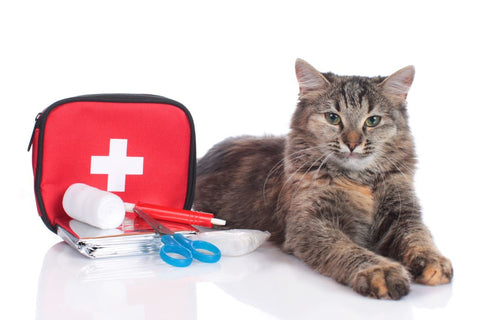

Key Highlights
- Being prepared with a dog first aid kit can help you navigate a medical emergency more calmly and confidently.
- First aid for dogs is not a substitute for veterinary care, but it can help stabilize and comfort your dog until they can see a vet.
- Essential items for your dog's first aid kit include phone numbers for emergency veterinarians and pet poison hotlines, as well as instructions for choking situations.
- When providing first aid for common dog injuries, it's important to clean wounds, provide support for sprains and strains, and cool burns.
- Advanced first aid techniques for dogs include understanding and applying pressure bandages, administering oral medications properly, performing CPR, and managing shock.
- Preparing a dog first aid kit with essential items like gauze, tweezers, and specific first aid advice based on your dog's needs is essential.
Introduction
No pet parent expects a medical emergency to happen, but when it does, being prepared can make all the difference. Having a dog first aid kit and knowing how to use it can help you navigate a medical emergency more calmly and confidently, especially if you have a puppy. While first aid for dogs is not a substitute for veterinary care, it can help stabilize and comfort your furry friend until they can receive professional medical attention. In fact, it might even save a dog’s life. Here are some important things to know about dog and puppy first aid.
In this blog, we will explore common dog injuries and how to treat them using basic first aid techniques. We will cover essential first aid for injuries such as cuts and scrapes, sprains and strains, burns, bites, broken bones, choking, poisoning, heatstroke, seizures, and eye injuries. Additionally, we will discuss more advanced first aid techniques, including understanding and applying pressure bandages, administering oral medications properly, performing CPR, and managing shock. We will also provide tips on how to prepare a dog first aid kit with essential items and customize it based on your dog's specific needs.
By the end of this blog, you will have a comprehensive understanding of dog first aid and be better equipped to handle common injuries that may arise.
Essential First Aid for Common Dog Injuries
When it comes to common dog injuries, having a basic knowledge of first aid can make a world of difference. While it's important to remember that first aid is not a substitute for veterinary care, it can help stabilize your dog and provide comfort until they can see a professional. In this section, we will dive into the essential first aid steps for common dog injuries, including cuts and scrapes, sprains and strains, burns, bites, broken bones, choking, poisoning, heatstroke, seizures, and eye injuries. By following these steps, you can help ensure that your furry friend receives the immediate attention they need before veterinary care is available, potentially saving your injured pet's life in a medical emergency.
1. Cuts, Scrapes and Bleeding: Initial Cleaning and Care
Cuts and scrapes are common injuries in dogs, and knowing how to provide initial cleaning and care can help prevent infection and promote healing. Here are the steps to follow:
- Apply gentle pressure: If the wound is bleeding, apply gentle pressure with a clean cloth to help stop the bleeding.
- Clean the wound: Use a mild antiseptic solution or saline solution to clean the wound. Avoid using hydrogen peroxide or alcohol, as they can damage healthy tissues.
- Apply an antibiotic ointment: After cleaning the wound, apply a thin layer of antibiotic ointment to help prevent infection.
- Cover the wound: Use a clean bandage or gauze to cover the wound and secure it in place. Change the bandage regularly and watch for signs of infection, such as redness, swelling, or discharge.
Remember, if the cut or scrape is deep, won't stop bleeding, or shows signs of infection, it's important to seek veterinary care. First aid is meant to stabilize the injury temporarily, but a professional evaluation is necessary for proper treatment and healing.
2. Sprains and Strains: Immediate Actions and Supports
To address sprains and strains in your dog, immediate action is crucial. Start by restricting your dog's movement to prevent further injury. Apply a cold compress to the affected area to reduce swelling. Offer gentle support by using a bandage or a makeshift splint if necessary. Ensure your furry friend rests and avoids activities that may worsen the injury. If the pain persists or if there's no improvement, seek veterinary care promptly to provide the best support for your pet's recovery. Remember, quick action can make a significant difference in your dog's healing process.
3. Burns: First Aid Steps and Cooling Techniques
To address burns in dogs, always prioritize safety. Begin by assessing the severity of the burn; for minor burns, cool the area with cold water and apply a clean cloth. Avoid using ice or butter. For more serious burns, seek immediate veterinary care. Monitor for signs of shock, such as rapid breathing or pale gums. Cooling techniques should be gentle to prevent further damage. Remember, quick action can make a significant difference in your dog's recovery.
4. Bites: Cleaning and Preventing Infection
For bites, cleaning the wound is crucial to prevent infection. Start by gently washing the area with mild soap and water. Apply an antibiotic ointment and cover with a clean bandage. Monitor for signs of infection like redness or swelling. If the bite is deep or from an unfamiliar animal, seek veterinary care. Remember, prevention is key, so always supervise interactions with other animals and teach children about pet safety. Proper care of bites ensures a quick recovery and a happy, healthy pet.
5. Broken Bones: Immobilization and Comfort
If your dog has a suspected broken bone, the first step is to keep them as calm and still as possible. Immobilize the injured limb using a splint or bandage and avoid putting pressure on the area. Providing comfort to your furry friend is crucial; use a clean cloth or padding to support the broken bone gently. Remember, immediate veterinary care is essential to ensure proper treatment and recovery. In an emergency, it is important to safely move or transport an injured dog with the help of someone else. For a small dog, put them into their carrier or use a suitable container such as a strong cardboard box. Always prioritize the well-being and comfort of your pet in such situations.
6. Choking: Clearing the Airway Safely
If your dog is choking, it's crucial to act quickly and clear the airway safely. Avoid panicking and stay calm to assist your furry friend effectively. Start by opening your dog's mouth to check for any obstruction. If you can see and safely reach the object blocking the airway, carefully remove it with your fingers or attempt a modified Heimlich maneuver. To perform this maneuver, stand or kneel behind your dog and place your hands under his body just behind his ribs. Thrust quickly upwards and forwards to attempt a forceful expulsion of the obstruction. However, be cautious not to push it further down. If the object is not visible or you can't retrieve it easily, seek immediate veterinary care to ensure your dog's well-being. If you are unable to reach the object with your fingers or through the modified Heimlich maneuver, try striking the rib cage firmly with the palm of your hand three or four times. Repeat until the object dislodges or you arrive at the vet.
7. Poisoning: Immediate Toxins Management
If your dog shows signs of poisoning, immediate action is crucial. Contact a vet or the Pet Poison Helpline promptly. Avoid giving any remedies without professional advice. For certain ingestions, inducing vomiting could worsen the situation. Keep packaging handy for the vet to identify the toxin. Rushing your pet to a veterinary hospital is vital for specific first aid care, especially if they are experiencing symptoms such as internal bleeding, a swollen abdomen, or other signs of toxicity.
8. Heatstroke: Cooling and Hydration Methods
To help a dog experiencing heatstroke, prompt cooling is vital. Move the dog to a cool place and apply cold, wet towels to their body. Offer small amounts of water to drink to prevent dehydration and diarrhea. Avoid ice-cold water as it can constrict blood vessels. Use a fan or air conditioning to aid in cooling. Monitor the dog's temperature and seek veterinary care immediately. Remember, heatstroke is a medical emergency and quick action can save your dog's life. If you suspect your dog is suffering from heat stroke, it is important to act quickly and follow these cooling and hydration methods.
9. Seizures: Keeping Your Dog Safe
During seizures, ensure your dog's safety by moving any harmful objects away. Avoid restraining them but gently guide them from danger. Time the seizure and contact your vet if it lasts longer than five minutes or if another seizure follows quickly. Stay calm; speak softly to soothe your dog. Note any unusual symptoms and provide this information to your vet. After the seizure, offer comfort and a quiet environment for recovery. Monitor their behavior and seek veterinary advice promptly if needed.
10. Eye Injuries: Gentle Care and Prevention
If your dog sustains an eye injury, approach with caution to avoid further harm. Keep your pet calm and gently examine the affected eye. If there's an object in the eye, avoid removing it - let a vet handle it. Rinse the eye with water if needed, and seek immediate veterinary care if the problem persists. To prevent eye injuries, be cautious during playtime and consider protective eyewear for activities with potential risks. Your furry friend's eyes are sensitive, so handle them with care and prevent them from rubbing their eyes with their paws or against objects.
Advanced First Aid Techniques for Dogs
In addition to basic first aid, there are some advanced techniques that can be useful in emergency situations. These techniques include:
- Understanding and applying pressure bandages to control bleeding and provide support to injured limbs.
- Administering oral medications properly, following the guidance of a veterinarian.
- Performing CPR (cardiopulmonary resuscitation) on dogs in cardiac arrest.
- Managing shock by keeping the dog calm, warm, and providing basic life support until veterinary care is available.
While these techniques can be valuable in emergency situations, it's important to remember that they are not substitutes for proper veterinary care. Always consult with a veterinarian for specific guidance and instructions.
Understanding and Applying Pressure Bandages
Pressure bandages can be useful for controlling bleeding and providing support to injured limbs. Here's how to apply a pressure bandage:
- Secure the dog and assess the bleeding. Apply direct pressure with a clean cloth or gauze pad to stop the bleeding.
- Once the bleeding is under control, clean the wound with water or a saline solution.
- Place a non-stick pad or sterile gauze pads over the wound, and then wrap a bandage around the affected area to apply pressure.
- Make sure the bandage is secure but not too tight to restrict blood circulation. Monitor the bandage regularly to ensure it remains in place and adjust if necessary.
- Seek veterinary attention for any severe or persistent bleeding, or if the wound does not heal properly.
Remember, pressure bandages can help control bleeding, but they are not a substitute for proper veterinary care. It's important to seek professional evaluation and treatment for any significant injuries.
Administering Oral Medications Properly
Administering oral medications to dogs requires care and precision. Here are some tips for properly administering oral medications:
- Secure the dog and ensure they are calm and comfortable.
- Follow the veterinarian's instructions regarding dosage and frequency of administration.
- Use a pet-friendly medication dispenser or pill pocket to hide the medication and make it easier for your dog to swallow.
- If necessary, gently open your dog's mouth and place the medication on the back of their tongue. Close their mouth and hold it closed until they swallow.
- Reward your dog with praise or a treat after successfully administering the medication.
If you're having difficulty administering oral medications or if your dog consistently refuses to take them, consult with your veterinarian for alternative options or techniques.
The Correct Way to Perform CPR on Dogs
Performing CPR on a dog in cardiac arrest can be a life-saving technique. Here's the correct way to perform CPR on dogs:
- Secure the dog on a flat surface and ensure their airway is clear.
- Check for a heartbeat by feeling the chest just behind the elbow or by finding a pulse on the inner thigh near the groin.
- If there is no heartbeat or pulse, begin chest compressions. For small dogs, use your thumb and fingers to compress the chest. For larger dogs, press on the widest part of the chest.
- Administer rescue breaths by covering the dog's nose with your mouth and blowing gently until their chest rises.
- Continue performing chest compressions and rescue breaths in the appropriate ratios until the dog's heartbeat and breathing resume or veterinary care is available.
CPR should only be performed by individuals trained in the technique. It's essential to seek veterinary care as soon as possible for further evaluation and treatment.
Managing Shock: Symptoms and First Aid
Shock is a serious condition that requires immediate attention. Here are the symptoms and steps to take for managing shock in dogs:
- Secure the dog and keep them calm, warm, and comfortable.
- Monitor for symptoms of shock, which may include rapid weak pulses, shallow or distressed breathing, pale gums, listlessness, or collapse.
- If the dog is unconscious or not breathing, perform CPR.
- Seek immediate veterinary care to address the underlying cause of shock and provide appropriate treatment.
- During transport, keep the dog warm and try to minimize stress and physical exertion.
Shock is a medical emergency, and it's crucial to seek veterinary attention as soon as possible. Prompt treatment can significantly improve the chances of a positive outcome.
Preparing a Dog First Aid Kit
Having a well-stocked dog first aid kit is essential for handling emergencies. Here are some tips for preparing a dog first aid kit:
- Gather essential items such as gauze, tweezers, bandages, scissors, clean cloths, and hydrogen peroxide.
- Keep emergency phone numbers handy, including your veterinarian, local emergency veterinarians, and poison control hotlines.
- Customize your first aid kit based on your dog's specific needs, such as breed or medical conditions.
- Regularly check and update your first aid kit to ensure all items are in good condition and not expired.
A well-prepared and customized first aid kit can be a lifesaver in emergency situations. Remember to familiarize yourself with the contents of the kit and how to use them properly.
Essential Items for Your Dog’s First Aid Kit
A well-stocked dog first aid kit should include essential items to handle emergencies. Here are some must-have items:
- Gauze pads for cleaning wounds and applying pressure.
- Nonstick bandages for wrapping wounds or maintaining pressure.
- Antibiotic spray or ointment to treat cuts, scraps and other minor injuries or irritations to the skin.
- Tweezers for removing ticks or splinters.
- Scissors for cutting bandages or materials.
- Sterile gloves to protect your hands during first aid procedures.
- Digital thermometer to get an accurate read of your dog's temperature.
- Clean cloths or towels for cleaning wounds and applying cold compresses.
- Hydrogen peroxide to induce vomiting (if advised by a veterinarian).
- An extra leash and collar incase something happens to yours, or you find an injured stray.
- Soft muzzle's can keep both you and a frantic or scared dog safe in tense situations.
Remember to regularly check and replace expired items in your dog's first aid kit. It's also important to include any specific medications, health supplements or supplies recommended by your veterinarian.
Customizing Your Kit Based on Your Dog's Needs and Breed
Customizing your dog's first aid kit based on their specific needs is essential. Here are some factors to consider when customizing the kit:
- Breed: Certain breeds may be prone to specific medical conditions or injuries. Consult with your veterinarian for breed-specific first aid advice and supplies.
- Allergies: If your dog has known allergies, include any necessary medications or treatments in the first aid kit.
- Medical conditions: If your dog has any pre-existing medical conditions, consult with your veterinarian for specific first aid advice and supplies.
By customizing your dog's first aid kit, you can ensure that you have the necessary supplies to address any specific needs or conditions your dog may have.
Conclusion
In times of emergency, knowing how to administer dog first aid to your furry friend can make a real difference. From cuts and scrapes to heatstroke and seizures, understanding the basics of dog first aid is crucial for every pet owner. By learning how to recognize and address common injuries promptly, you can ensure the well-being of your beloved companion. Remember, a well-prepared first aid kit tailored to your dog's needs can be a lifesaver in unexpected situations. Stay informed, stay prepared, and most importantly, keep your dog safe and healthy!
Frequently Asked Questions
How often should I check and update my dog's first aid kit?
It's essential to regularly check and update your dog's first aid kit. This should be done at least once every six months or whenever items expire or become damaged. It's also important to check the kit before any outdoor adventures or trips to ensure all essential items are present and in good condition.
Can I use human first aid supplies on dogs?
While some human first aid supplies can be used in a pinch for dogs, it's essential to exercise caution. Human supplies may not be suitable or safe for dogs, so it's best to use dedicated dog first aid supplies whenever possible. Consult with your veterinarian for guidance on using human supplies in emergencies.
What are the signs that my dog needs immediate vet attention?
Signs that your dog needs immediate veterinary attention include difficulty breathing, pale gums, rapid breathing, severe bleeding, loss of consciousness, seizures, or any other severe or life-threatening symptoms. Trust your instincts, and if you're unsure, it's always best to seek veterinary care to ensure your dog's well-being.
How can I prevent common injuries in dogs?
Preventing common injuries in dogs involves creating a safe environment for them. Remove any hazards or potential dangers, such as sharp objects, toxic substances, or open flames. Supervise your dog during playtime and exercise, and provide proper training and socialization to prevent accidents or aggressive behavior.







